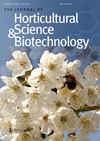Genome survey and identification of key genes associated with freezing tolerance in genomic draft of hexaploid wild Camellia oleifera
IF 2.1
4区 农林科学
Q2 HORTICULTURE
Journal of Horticultural Science & Biotechnology
Pub Date : 2023-11-05
DOI:10.1080/14620316.2023.2272155
引用次数: 0
Abstract
ABSTRACTCamellia oleifera Abel. is the dominant woody oil crop under significant development in China. Wild C. oleifera in Lu Mountain is a valuable genetic resource with strong freezing tolerance. With high-throughput sequencing, the genome of wild C. oleifera in Lu Mountain was analysed and 700.3 Gb clean reads were obtained. The genome of wild C. oleifera was estimated as allohexaploid, and its haplotype genome size was about 2.69 Gb-2.79 Gb, with repeat content of 63.01%-73.02% and heterozygosity of 6.30%-7.43%, belonging to a very complex genome. The genomic draft was assembled that contained a total of 6,952,303 scaffolds with N50 length of 1.23 kb, and the overall length was 2.39 Gb with GC content of 40.87%. In the genomic draft, 1,104,618 SSRs were identified; scaffold1096012 and scaffold1779458 were identified as key genes associated with freezing tolerance combined with the transcriptome data of field plus lab experiments. In this study, the genomic background of hexaploid wild C. oleifera in Lu Mountain was revealed. This lays the foundation for obtaining the high-quality chromosome-level reference genome of wild C. oleifera. The identification of SSRs and key genes associated with freezing tolerance may contribute to the efficient exploration and utilisation of this genetic resource.KEYWORDS: Camellia oleiferahigh-throughput sequencinggenome surveygenomic draftsimple sequence repeatfreezing tolerance AcknowledgementsThis research was funded by the National Natural Science Foundation of China (grant no. 32270238).Disclosure statementNo potential conflict of interest was reported by the author(s).Data availability statementThe data that support the findings in this research are deposited in the short read archive (SRA) databank (https://www.ncbi.nlm.nih.gov/sra) with the accession number PRJNA984951.Author’s contributionXH and RJ designed the experiments. XH conducted the experiments with helps from XK, ZJ, ZY and RJ. XH, XK, ZJ, ZY and RJ participated in data analyses. All authors contributed to writing of the manuscript.Consent for publicationAll the authors have read and consented to submit the manuscript.Ethical approvalThe article does not contain any studies with human participants or animals performed by any of the authors.Supplementary materialSupplemental data for this article can be accessed online at https://doi.org/10.1080/14620316.2023.2272155Additional informationFundingThis work was supported by the National Natural Science Foundation of China (32270238).野生油茶六倍体基因组图谱中耐寒性相关关键基因的基因组调查与鉴定
【摘要】油茶。是中国发展较快的主要木本油料作物。庐山野生油桐是一种耐寒性强的珍贵遗传资源。利用高通量测序技术对庐山野生油桐基因组进行了分析,获得了700.3 Gb的clean reads。野生油桐基因组估计为异源六倍体,其单倍型基因组大小约为2.69 Gb ~ 2.79 Gb,重复数为63.01% ~ 73.02%,杂合度为6.30% ~ 7.43%,属于非常复杂的基因组。组装基因组草图,共包含6952303个支架,N50长度为1.23 kb,总长度为2.39 Gb, GC含量为40.87%。在基因组草案中,鉴定了1,104,618个ssr;结合田间和室内实验转录组数据,鉴定出脚手架1096012和脚手架1779458是与抗冻性相关的关键基因。本研究揭示了庐山野生油桐六倍体的基因组背景。这为获得高质量的野生油桐染色体水平参考基因组奠定了基础。SSRs和抗冻性相关关键基因的鉴定将有助于对这一遗传资源的有效开发和利用。关键词:油茶;高通量测序;基因组调查;32270238)。披露声明作者未报告潜在的利益冲突。数据可用性声明支持本研究结果的数据已存入SRA数据库(https://www.ncbi.nlm.nih.gov/sra),登录号为PRJNA984951。xh和RJ设计了实验。XH在XK, ZJ, ZY和RJ的帮助下进行了实验。XH, XK, ZJ, ZY, RJ参与数据分析。所有作者都对手稿的撰写做出了贡献。所有作者已阅读并同意提交稿件。伦理批准本文不包含任何作者进行的任何人类参与者或动物研究。补充资料本文补充资料可从https://doi.org/10.1080/14620316.2023.2272155Additional info网站获取。基金资助:国家自然科学基金(32270238)
本文章由计算机程序翻译,如有差异,请以英文原文为准。
求助全文
约1分钟内获得全文
求助全文
来源期刊
CiteScore
3.90
自引率
5.30%
发文量
67
审稿时长
3 months
期刊介绍:
The Journal of Horticultural Science and Biotechnology is an international, peer-reviewed journal, which publishes original research contributions into the production, improvement and utilisation of horticultural crops. It aims to provide scientific knowledge of interest to those engaged in scientific research and the practice of horticulture. The scope of the journal includes studies on fruit and other perennial crops, vegetables and ornamentals grown in temperate or tropical regions and their use in commercial, amenity or urban horticulture. Papers, including reviews, that give new insights into plant and crop growth, yield, quality and response to the environment, are welcome, including those arising from technological innovation and developments in crop genome sequencing and other biotechnological advances.

 求助内容:
求助内容: 应助结果提醒方式:
应助结果提醒方式:


